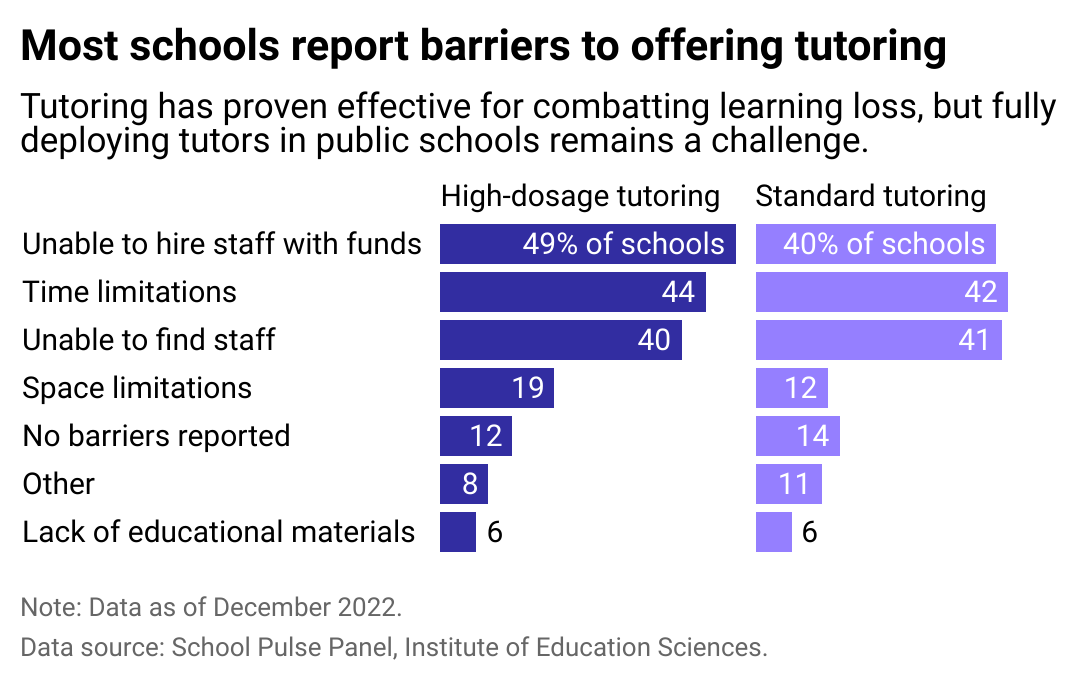As schools rely on tutoring to rebound from learning loss, finding tutors proves difficult

Indypendenz // Shutterstock
As schools rely on tutoring to rebound from learning loss, finding tutors proves difficult
Tutor helping student with math lessons.
School-age children’s learning progress continues to reverberate in the wake of the COVID-19 pandemic. According to a 2023 meta-analysis of evidence from developed countries published in the journal Nature Human Behaviour, children missed out on the equivalent of 35% of a typical academic school year during the pandemic, and overall learning progress slowed significantly. Such learning losses have schools scrambling to fill the gaps.
An ample body of research has demonstrated that high-impact tutoring remains among the few school-based interventions that significantly impact math and reading achievement. A 2020 paper from the Abdul Latif Jameel Poverty Action Lab examining evidence from 96 randomized studies found that tutoring interventions account for learning improvement comparable to students’ advancing from the 50th to the 66th achievement percentile in math and reading comprehension. Intensive, or “high-dose,” tutoring has helped students regain some learning-loss ground and—despite its increased cost relative to teacher-based tutoring—proven cost-effective at scale, suggesting a workable avenue for school districts and even state-level education departments seeking a sustainable means of providing necessary resources to their students.
More than 2 in 5 U.S. school districts and charter schools have planned to direct some of their federal COVID-19 relief funds toward tutoring efforts. To recover from the learning loss accumulated over the past few years, more than 2 in 5 U.S. school districts and charter schools have planned to direct some of their federal COVID-19 relief funds toward tutoring efforts.
In the largest public investment in K-12 education, the federal government allocated $190 billion for elementary and secondary schools under Elementary and Secondary School Emergency Relief Fund packages. Most school districts—having underspent at the beginning of the aid term—now face spending deadlines by September 2024, underscoring the importance of securing regular funding to support tutoring programs.
HeyTutor cited survey data from the Institute of Education Sciences to examine the problems public schools face in hiring tutors and hosting tutoring programs.
![]()

HeyTutor
Challenges facing schools
Split bar chart showing nearly half of schools lack funding to hire staff for high dosage tutoring and 40% lack funding for traditional tutoring. Other prevalent barriers are time limitations and difficulty to find staff.
The IES surveyed about 2,400 public K-12 schools across the U.S., and almost half of the schools providing students with high-dosage tutoring cited lack of funding to hire the staff needed to provide such tutoring as a barrier.
High-dosage tutoring—which according to Duke University’s Social Science Research Institute is generally defined as tutoring with a frequency of three or more sessions per week of no less than 30 minutes each and a maximum 3:1 student-tutor ratio—is a method that requires specially trained professionals capable of developing a “sustained and strong” relationship with their students.
Faced with a lack of trained professionals, North Carolina’s Guilford County schools turned to paraprofessionals, graduate students, and tutors from outside organizations to assist their own certified teachers in leading tutoring efforts. The district also partnered with two local universities to boost its team of tutors.
To tackle a similar problem of limited availability of trained tutors, the Dallas Independent School District in Texas announced efforts to recruit more retired teachers to expand school-hour tutoring.
Besides money, incorporating high-dosage tutoring also requires time. A statewide tutoring initiative in Tennessee, encompassing 87 districts with more than 200,000 students, seeks to address the issue of the timing of in-school tutoring services. Having suffered from consistently low participation rates when scheduled for after-school hours, the state’s tutoring efforts are now offered during school hours, which has helped reach many more students while not requiring them to sacrifice extracurricular activities.
School districts have devised ingenious solutions to some of the most common barriers to successful tutoring programs. Beyond solving for the pandemic-induced learning losses, improving student achievement makes good sense.
Story editing by Brian Budzynski. Copy editing by Paris Close.
This story originally appeared on HeyTutor and was produced and
distributed in partnership with Stacker Studio.
